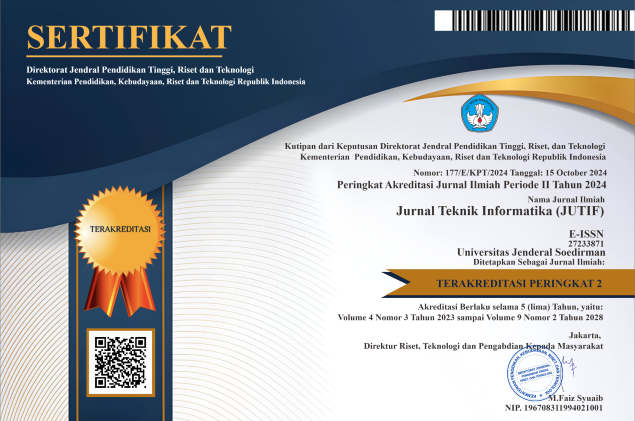Stacking Ensemble RNN-LSTM Models for Forecasting the IDR/USD Exchange Rate with Nonlinear Volatility
DOI:
https://doi.org/10.52436/1.jutif.2025.6.4.5057Keywords:
deep learning, exchange rate prediction, LSTM, RNN, stacking ensemble, time series analysisAbstract
Abstract - Predicting exchange rates with high volatility and nonlinear patterns presents a critical challenge in financial analysis. Deep learning models such as RNN and LSTM are widely used for their ability to capture temporal dependencies, yet each has limitations when applied individually. This study aims to enhance the prediction accuracy of the Indonesian Rupiah (IDR) to US Dollar (USD) exchange rate by implementing a stacking ensemble approach that combines RNN and LSTM models. The dataset consists of 522 weekly observations from January 2015 to December 2024, sourced from the official website of Bank Indonesia (bi.go.id). In the proposed framework, RNN and LSTM serve as base learners, while linear regression acts as the meta-learner. Model performance is evaluated using RMSE, MAPE, and MSE. The results indicate that the stacking ensemble consistently outperforms the individual models, achieving an RMSE of 117.91, a MAPE of 0.01, and an MSE of 13,901.67. The model effectively captures historical patterns and delivers stable and accurate predictions. In conclusion, the stacking ensemble approach developed in this study contributes to the advancement of ensemble learning techniques in computer science and offers practical value for financial decision-makers, particularly in managing complex and dynamic exchange rate scenarios.
Downloads
References
N. O. Syamsiah and I. Purwandani, “Penerapan Metode Stacking Untuk Meningkatkan Akurasi Hasil Peramalan Konsumsi Listrik,” Journal of System and Computer Engineering (JSCE) ISSN, vol. 4, no. 1, pp. 15–25, Jan. 2023, doi: https://doi.org/10.47650/jsce.v4i1.665.
K. A. Notodiputro, Y. Angraini, and L. N. A. Mualifah, Analisis Data Deret Waktu dengan Python, 1st ed. Bogor: PT Penerbit IPB Pres, 2025.
P. Das and S. Barman, “Perspective Chapter: An Overview of Time Series Decomposition and Its Applications,” Applied and Theoretical Econometrics and Financial Crises, pp. 1–15, Feb. 2025, doi: 10.5772/intechopen.1009268.
J. Hao and F. Liu, “Improving long-term multivariate time series forecasting with a seasonal-trend decomposition-based 2-dimensional temporal convolution dense network,” Sci Rep, vol. 14, no. 1, pp. 1–13, Dec. 2024, doi: 10.1038/s41598-024-52240-y.
A. Casolaro, V. Capone, G. Iannuzzo, and F. Camastra, “Deep Learning for Time Series Forecasting: Advances and Open Problems,” Nov. 01, 2023, Multidisciplinary Digital Publishing Institute (MDPI). doi: 10.3390/info14110598.
S. B. Chudo and G. Terdik, “Modeling and Forecasting Time-Series Data with Multiple Seasonal Periods Using Periodograms,” Econometrics, vol. 13, no. 2, p. 14, Mar. 2025, doi: 10.3390/econometrics13020014.
M. Waqas and U. W. Humphries, “A critical review of RNN and LSTM variants in hydrological time series predictions,” MethodsX, vol. 13, p. 102946, 2024, doi: https://doi.org/10.1016/j.mex.2024.102946.
F. F. Mojtahedi, N. Yousefpour, S. H. Chow, and M. Cassidy, “Deep Learning for Time Series Forecasting: Review and Applications in Geotechnics and Geosciences,” Computational Methods in Engineering, pp. 1–31, Aug. 2025, doi: 10.1007/s11831-025-10244-5.
I. Cahya and T. Ningsih, “Sistem Prediksi Berbasis Recurrent Neural Network untuk Klasifikasi Penyakit Kanker,” JURNAL ILMU KOMPUTER DAN TEKNOLOGI, vol. 1, no. 1, pp. 7–11, Jan. 2025, [Online]. Available: https://jurnal.kolabs.id/index.php/JIKT/
I. Farisi, J. Shadiq, W. Priyadi, D. Maulana, and S. F. Gusril, “Penerapan Model Recurrent Neural Network (RNN) untuk Prediksi Curah Hujan Berbasis Data Historis,” INFORMATION SYSTEM FOR EDUCATORS AND PROFESSIONALS, vol. 9, no. 2, pp. 217–226, 2024.
W. A. Pratiwi, A. F. Rizki, K. A. Notodiputro, Y. Angraini, and L. N. A. Mualifah, “THE COMPARISON OF ARIMA AND RNN FOR FORECASTING GOLD FUTURES CLOSING PRICES,” BAREKENG: Journal of Mathematics and Its Applications, vol. 19, no. 1, pp. 0397–0406, Mar. 2025.
A. Casolaro, V. Capone, G. Iannuzzo, and F. Camastra, “Deep Learning for Time Series Forecasting: Advances and Open Problems,” Nov. 01, 2023, Multidisciplinary Digital Publishing Institute (MDPI). doi: 10.3390/info14110598.
B. Ghojogh and A. Ghodsi, “Recurrent Neural Networks and Long Short-Term Memory Networks: Tutorial and Survey,” Ithaca, NY, arXiv:2304.11461, Apr. 2023. doi: https://arxiv.org/abs/2304.11461.
G. Shankarlingam and K. Thirupathireddy, “DRAWBACKS OF LSTM ALGORITHM: A CASE STUDY,” Dec. 2023. doi: 10.2139/ssrn.5080605.
G. G. Ghiffary, E. D. D. Yanuari, K. A. Notodiputro, Y. Angraini, and L. N. A. Mualifah, “Comparative Performance Of Sarimax And Lstm Model In Predicting Import Quantities Of Milk, Butter, And Eggs,” BAREKENG: J. Math. & App, vol. 19, no. 1, pp. 407–0418, Mar. 2025, doi: 10.30598/barekengvol19iss1pp0407-0418.
A. V. Septiani, F. M. Afendi, and A. Kurnia, “Perbandingan Metode GARCH, LSTM, GRU, dan CNN pada Peramalan Volatilitas Kurs,” Limits: Journal of Mathematics and Its Applications, vol. 22, no. 1, pp. 147–167, Mar. 2025, doi: 10.12962/limits.v22i1.3384.
I. Magfirrah, M. Ilma, K. A. Notodiputro, Y. Angraini, and L. N. A. Mualifah, “Comparative Analysis of ARIMA and LSTM for Forecasting Maximum Wind Speed in Kupang City, East Nusa Tenggara,” Jambura Journal of Mathematics, vol. 6, no. 2, pp. 169–175, Aug. 2024, doi: 10.37905/jjom.v6i2.25834.
Anggi Adrian Danis, Yenni Kurniawati, Nonong Amalita, and Fadhilah Fitri, “Forecasting the Exchange Rate of Yen to Rupiah Using the Long Short-Term Memory Method,” UNP Journal of Statistics and Data Science, vol. 1, no. 5, pp. 449–455, Nov. 2023, doi: 10.24036/ujsds/vol1-iss5/114.
D. Wang, X. Cui, and D. Niu, “Wind Power Forecasting Based on LSTM Improved by EMD-PCA-RF,” Sustainability (Switzerland), vol. 14, no. 12, Jun. 2022, doi: 10.3390/su14127307.
Y. Bai, J. Sun, J. Luo, and ZhangXiaobin, “Forecasting Financial Time Series with Ensemble Learning,” International Symposium on Intelligent Signal Processing and Communication System (ISPACS 2010) December 6-8, no. 3, pp. 1–4, 2010.
M. Leutbecher and T. N. Palmer, “Ensemble forecasting,” J Comput Phys, vol. 227, no. 7, pp. 3515–3539, Mar. 2008, doi: 10.1016/j.jcp.2007.02.014.
I. Zaier, C. Shu, T. B. M. J. Ouarda, O. Seidou, and F. Chebana, “Estimation of ice thickness on lakes using artificial neural network ensembles,” J Hydrol (Amst), vol. 383, no. 3–4, pp. 330–340, Mar. 2010, doi: 10.1016/j.jhydrol.2010.01.006.
N. K. Majid, C. Supriyanto, and A. Marjuni, “Peningkatan Keberagaman Data untuk Klasifikasi Penyakit Diabetes Berbasis Stacking Ensemble Learning,” Jurnal Informatika: Jurnal Pengembangan IT, vol. 10, no. 1, pp. 1–10, Jan. 2025, doi: 10.30591/jpit.v10i1.7375.
E. Wibowo and I. Pratama, “Analisis Sentimen Terhadap Ulasan Hotel Melalui Platform Google Review Menggunakan Metode Stacking,” Jurnal Teknologi Dan Sistem Informasi Bisnis, vol. 6, no. 4, pp. 774–784, Oct. 2024, doi: 10.47233/jteksis.v6i4.1475.
M. N. Azimi, M. M. Rahman, and T. Maraseni, “Advancing sustainable development goal 8 Targets: The role of institutional Quality, economic Complexity, and state fragility in G20 nations (2000–2023),” Research in Globalization, vol. 10, Jun. 2025, doi: 10.1016/j.resglo.2025.100278.
H. Kreinin and E. Aigner, “From ‘Decent work and economic growth’ to ‘Sustainable work and economic degrowth’: a new framework for SDG 8,” Empirica, vol. 49, no. 2, pp. 281–311, May 2022, doi: 10.1007/s10663-021-09526-5.
C. Alkahfi, A. Kurnia, and A. Saefuddin, “Perbandingan Kinerja Model Berbasis RNN pada Peramalan Data Ekonomi dan Keuangan Indonesia,” MALCOM: Indonesian Journal of Machine Learning and Computer Science, vol. 4, no. 4, pp. 1235–1243, Jul. 2024, doi: 10.57152/malcom.v4i4.1415.
A. Waladi, Y. Perdana, U. Jambi, F. Sains dan Teknologi, and N. Raisa Hanum, “Stock Price Prediction Using Machine Learning-Based on RNN Algorithms,” Media Journal of Information System and Informatics, vol. 1, no. 1, pp. 1–8, Nov. 2024, [Online]. Available: http://www.mase.or.id
R. Achmad, Y. Tokoro, J. Haurissa, and A. Wijanarko, “Recurrent Neural Network-Gated Recurrent Unit for Indonesia-Sentani Papua Machine Translation,” Journal of Information Systems and Informatics, vol. 5, no. 4, pp. 1449–1460, Dec. 2023, doi: 10.51519/journalisi.v5i4.597.
L. Larasati, S. Saadah, and P. E. Yunanto, “Recurrent Neural Networks (RNN) and Long Short-Term Memory (LSTM) Methods to Forecast Daily Turnover at BM Motor Ngawi,” Indonesian Journal of Artificial Intelligence and Data Mining, vol. 7, no. 1, p. 141, Jan. 2024, doi: 10.24014/ijaidm.v7i1.27643.
A. A. Ningrum, I. Syarif, A. I. Gunawan, E. Satriyanto, and R. Muchtar, “Algoritma Deep Learning-LSTM untuk Memprediksi Umur Transformator,” Jurnal Teknologi Informasi dan Ilmu Komputer, vol. 8, no. 3, pp. 539–548, Jun. 2021, doi: 10.25126/jtiik.2021834587.
R. Firdaus, H. Mukhtar, and Awaluddin, “Prediksi Indeks Harga Produsen Pertanian Karet Di Indonesia Menggunakan Metode LSTM,” Jurnal Fasilkom, vol. 13, no. 1, pp. 01–06, Apr. 2023, [Online]. Available: https://www.bappebti.go.id/.
M. Hussein and Y. Azhar, “Prediksi Harga Minyak Dunia Dengan Metode Deep Learning,” Fountain of Informatics Journal, vol. 6, no. 1, pp. 2548–5113, 2021, doi: 10.21111/fij.v6i1.4446.
G. Budiprasetyo, M. Hani’ah, and D. Z. Aflah, “Prediksi Harga Saham Syariah Menggunakan Algoritma Long Short-Term Memory (LSTM),” Jurnal Nasional Teknologi dan Sistem Informasi, vol. 8, no. 3, pp. 164–172, Jan. 2023, doi: 10.25077/teknosi.v8i3.2022.164-172.
R. Arum Pitaloka and R. Rahmawati, “PERBANDINGAN METODE ARIMA BOX-JENKINS DENGAN ARIMA ENSEMBLE PADA PERAMALAN NILAI IMPOR PROVINSI JAWA TENGAH,” Jurnal Gaussian, vol. 8, no. 2, pp. 194–207, 2019, [Online]. Available: http://ejournal3.undip.ac.id/index.php/gaussian
D. H. Wolpert, “Stacked generalization,” Neural Networks, vol. 5, no. 2, pp. 241–259, 1992, doi: 10.1016/S0893-6080(05)80023-1.
N. K. Majid, C. Supriyanto, and A. Marjuni, “Peningkatan Keberagaman Data untuk Klasifikasi Penyakit Diabetes Berbasis Stacking Ensemble Learning,” Jurnal Informatika: Jurnal Pengembangan IT, vol. 10, no. 1, pp. 1–10, Jan. 2025, doi: 10.30591/jpit.v10i1.7375.
R. Gao, M. Hu, R. Li, X. Luo, P. N. Suganthan, and M. Tanveer, “Stacked Ensemble Deep Random Vector Functional Link Network With Residual Learning for Medium-Scale Time-Series Forecasting,” IEEE Trans Neural Netw Learn Syst, vol. 36, no. 6, pp. 10833–10843, 2025, doi: 10.1109/TNNLS.2025.3529219.
W. N. Ismail, H. A. Alsalamah, and E. Mohamed, “GA-Stacking: A New Stacking-Based Ensemble Learning Method to Forecast the COVID-19 Outbreak,” Computers, Materials and Continua, vol. 74, no. 2, pp. 3945–3976, 2023, doi: 10.32604/cmc.2023.031194.
S. Lin and Y. Feng, “Research on Stock Price Prediction Based on Orthogonal Gaussian Basis Function Expansion and Pearson Correlation Coefficient Weighted LSTM Neural Network,” Advances in Computer, Signals and Systems, vol. 6, no. 5, 2022, doi: 10.23977/acss.2022.060504.
B. Long, F. Tan, and M. Newman, “Forecasting the Monkeypox Outbreak Using ARIMA, Prophet, NeuralProphet, and LSTM Models in the United States,” Forecasting, vol. 5, no. 1, pp. 127–137, Mar. 2023, doi: 10.3390/forecast5010005.
P. Cawood and T. van Zyl, “Evaluating State of the Art, Forecasting Ensembles- and Meta-learning Strategies for Model Fusion,” Jul. 2022, [Online]. Available: http://arxiv.org/abs/2203.03279
Additional Files
Published
How to Cite
Issue
Section
License
Copyright (c) 2025 Windy Ayu Pratiwi, I Made Sumertajaya , Khairil Anwar Notodiputro

This work is licensed under a Creative Commons Attribution 4.0 International License.



























